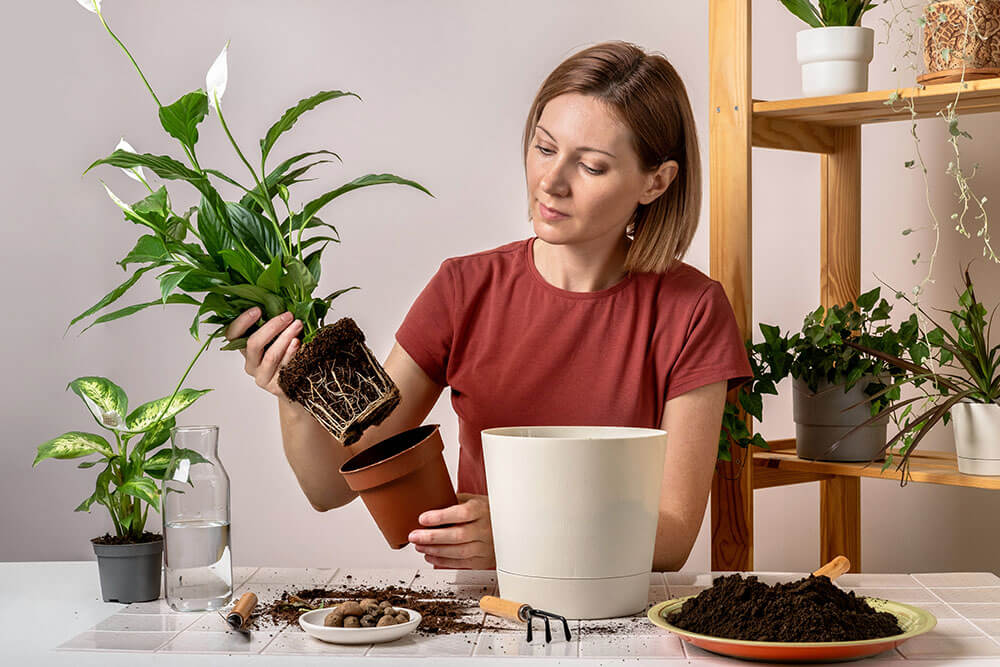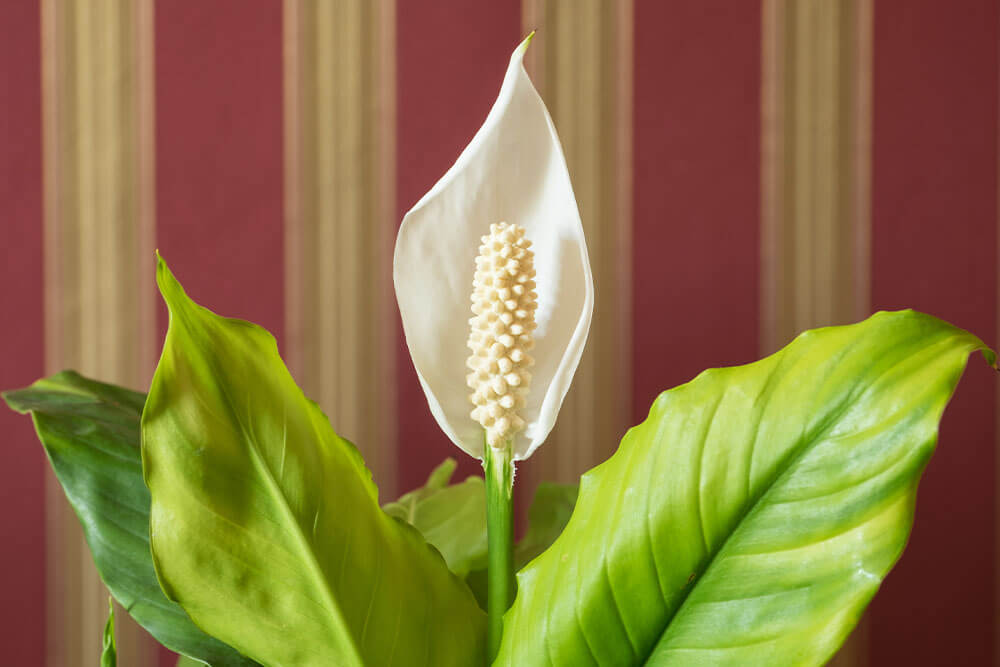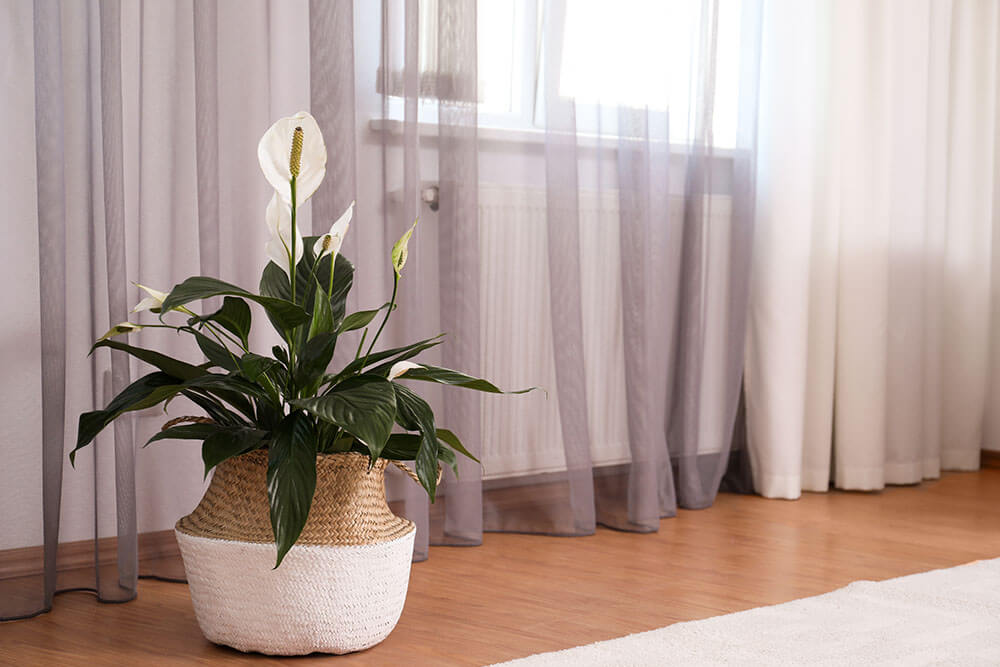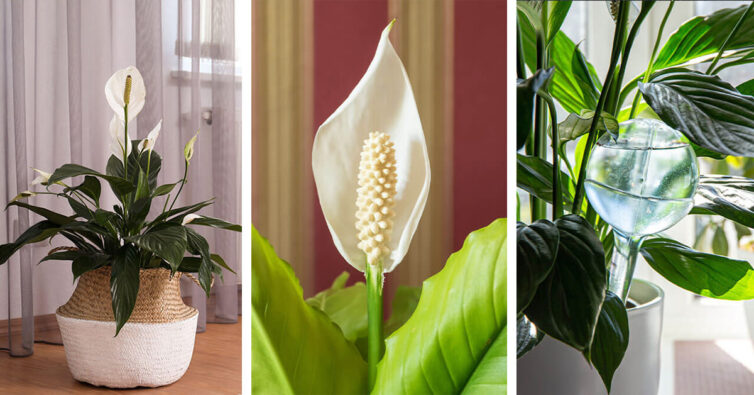Because it’s fairly easy to grow and care for peace lilies, they are one of the most popular plants for your indoor garden. When the lily’s leaves droop, it’s time to water. If the tips are yellow, repot! When you have a plant that shows you what it needs, when it needs it, your job becomes a breeze.
Growing Peace Lily
The peace lily has shiny dark verdure leaves wearing spathes of white flowers like a crown. Peace lilies are among the sun worshipers of plants. The more light it gets, the faster it grows and blooms.
They’ll often fit nicely near a wind, measuring about 4 feet wide. Mind you, there are a couple of go-getters that grow to 6 feet by 6 feet, so definitely check your labels before buying.
If you’re looking for household greenery that’s easy on the budget, you’re in for luck. This flower is one of the most inexpensive ones you’ll find. Once home, if your house stays between 65 to 85 degrees, your plants will be happy, indeed.
Peace Lily Toxicity: Those of you with animals and children need to be judicious in terms of where you place your lily. The ASPCA warns that not only are peace lilies toxic to pets, they can harm humans, too. An upset stomach and drooling are two signs of ingestion.
Key Takeaways
- The Peace Lily is the perfect project for beginners as an introduction to flowering plants.
- This flower can handle some over-watering. The leaves and flowers will also indicate when something is wrong (wilting leaves, yellow leaves).
- Look at your available space. Some peace lilies only grow up to 15 inches tall, while others reach 3 to 6 feet.
- While peace lilies like a little shade, it is the sunlight that really brings out the blossoms.
Types of Peace Lilies
Thanks to hybridization, Peace Lillies have dozens of varieties, many of which are popular. Some are big, others small, some with white flowers, and others with golden-toned leaves.
- Clevelandii: A peace lily said to bring harmony to your home. Tolerant of fluorescent lighting and shady areas. It has a spread of 2-3 feet from which foliage may reach 18 inches.
- Domino: This is a medium-sized peace lily. It features variegated leaves. Sometimes the lines are dark green, and other times creamy!
- Golden Delicious: This peace lily has special features. As the flower emerges, they come in a spadix with white, yellowish, and green tints. Lower light requirements than some peace lilies.
- Mauna Loa Supreme: As the name implies, this plant has a tropical appeal, having leaves that can grow up to 9 inches wide. It has long-lasting blooms and an indoor size of about 3 feet.
- Mojo: A peace lily rapidly becoming the center of attention for indoor gardeners. Put it in a 6-inch pot, and it constantly yields blossoms.
- Power Petite: A tidy plant that grows to about 15 inches with crisp white flowers.
- Sensation: A peace lily that is best used for a tall vertical space since it can grow up to 6 feet and bear 20-inch long leaves.
- Starlight: Best known for yielding as many as 20 flours on one plant, this lily’s leaves are narrow with wavy margins.
- Wallisii: A sweet petite lily that grows no more than 2 feet tall. It bears rippled leaves, measures 8 inches, and the flowers are 3 inches.
When you repot your lily, look for offshoot clumps growing from the parent plant. You can do this any time of year. While the plant is out of its original container, tug at the adjacent crowns.
Alternatively, if there’s a spot on the parent toward the outside with 2-3 leaves, you can cut that part off and propagate it as well. Use 6-inch containers with potting mix. Give them a little water after planting, but avoid making the soil soggy. Believe it or not, your baby plants will have fairly healthy root systems in four weeks or less.
Planting Peace Lillies
The general rule of thumb is to plant your peace lily in a container twice as large as its root ball. Make sure the pot has a good draining system. After that, you shouldn’t have to repot for a couple of years, during spring. At that time, add fresh soil.
Planting Peace Lilies in Water
Some peace lilies can grow with no soil. Put them in a vase, suspected above the waterline. A layer of small stones helps with this location. From here, the roots seek out the water, but the plant never gets constantly wet.
Peace Lily illywhacker? The name for this flower is actually a misnomer. They have absolutely no connection to true lilies. Rather, this plant is a tropical evergreen that thrives on the forest floors of South America. If you can replicate partial light and proper moisture levels, a peace lily will flower in early summer, then keep producing blooms throughout the growing year.

Growing Peace Lilies Outdoors
If you live in USDA Hardiness zones 22 and up, you can grow peace lilies outside. Beyond that, cold conditions do not suit this plant. Temperatures dropping into the 40s F will kill them.
There is nothing stopping you from taking your potted peace lily for an outdoor adventure in the warm months. Put it in a nice sunny location. But if you feel the temperatures falling, get your plant back inside. Watch for potential insect hitchhikers.
Caring for Peace Lilies
There are five key factors to caring for your peace lily:
- All tied up! Peace Lilies like being a little root-bound. When it becomes obvious that the plant exceeds the container capacity, then sizes up in spring. You’ll notice the roots sneaking out of drainage holes. Terracotta vessels are your best choice.
- A little shady: Peace Lily loves sunlight, but not direct. Their natural habitat gives them spots of shade. Look for an east-facing window.
- Dig it: Peace lilies benefit from potting mix with organic matter mixed in.
- Thirsty or not? You are far better off slightly under-watering your pace lily than over-watering it. Touch the top inch of your lily’s soil. If it’s dry, you can water it safely. Those living in regions with highly chlorinated water might want to use filtered water instead.
- Some like it hot: Keep your peace lily out of areas with cold drafts. Keep your peace lily in temperatures ranging from 65-80F, and it’s “just right.” You can spritz them if your house is naturally dry, give them a light spritzing weekly for improved humidity.
- A friend in fertilizer: Peace lilies are hungry through the blossom season. They appreciate slow-release pellets as the flowers come forth. There’s no need to fertilize during winter months.
Dying plants dot your past because you give them too much water. It’s hard to kill a peace lily, however. If you over-water occasionally, don’t sweat it. Just let the plant dry out.
Peace Lily Common Pests & Plant Diseases
Even indoor plants can develop infestations of insects or develop diseases.
Critters
Spider mites are sneaky and small. They feed from any part of a plant and hide under the leaves where the veins are ripe for the taking. Watch for tiny silver webs and little brown scabs on the leaves. Hose your plant down and apply neem oil.
Mealybugs cluster under leaves like spider mites do. They are fluffy bugs, white or creamy colored. They will stunt plant growth. Yellow and browning leaves are common. Dab a solution of rubbing alcohol (70%) and water (30%). Insecticidal soap helps, too.
Aphids are green, white, or brown insets. They’ll camp out on the plant’s stems and veins. They’ll eat up new leaves before they even grow. Spray your plant lightly with soap and water. This should knock them off the lily.
Diseases
By far, root rot is the most prevalent disease indoor peace lilies develop. It happens when the plant is over-watered, and mold or fungus develops. Remember to keep your lilies watered appropriately. Check the soil to make sure it’s loamy.
You will need to repot a peace lily with root rot, getting whole new potting soil. Take the plant out of its current container and trim back any part of the root that looks dead or like it’s dying.
Mix the new soil with coco coir (fibrous part of the coconut shell) and perlite, or use a blend for African Violets.
Beyond this, the peace lily isn’t really prone to disease.
Award Spotlight: In June of 2015, the Peace Lily took center stage as the Houseplant of the Month. Deemed so by the Flower Council of Holland, the organization chooses a popular consumer plant specifically for indoor growth and gives it greater appreciation.

Common Peace Lily Problems
You may see brown tips develop on your peace lily. This occurs when there is too much or too little water. It also could result from low humidity or over-fertilization.
This can prove frustrating for new peace lily owners because you have to figure out which of the four problems is causal.
If the soil feels soggy, definitely let it dry out before you water it again. If the soil’s been dry, and the lily droops, it’s probably thirsty.
Curled or pale leaves suggest too much general light. Scorched leaves are due to direct sunlight.
Another problem that may cause you some struggle is blooming. Even the happiest of peace lilies may not bloom because the conditions aren’t quite what they had in the rainforest. Try diffused light, fertilizing consistently (per instructions), and adding humidity to the space.
Don’t be fooled, however. Peace lily buds are small and slowly unfurl, so at first, you might not notice them develop.
They bloom on their own proverbial clock. You should receive a bouquet twice a year in summer and fall.
NASA lists the Peace Lily among the plants in the Clean Air Act Study. The research determined Peace Lilies can filter out air pollutants. Both the leaves and the topsoil do the work while increasing moisture in the air.
The pollutant list includes formaldehyde, benzene, trichloroethylene, and ammonia. Other plants on NASA’s list include spider plants, ficus, and orchids.
Peace Lily Meaning, Symbolism, and Superstition

The gentle white flowers of the peace lily give it associations with purity, harmony, and innocence. In Feng Shui, practitioners place these plants in the home to restore balance, relieve anxiety, and open the path for positive “vibes.”
The direction in which you face the peace lily shows the area of your life on which you’re focusing. For example, put one facing the bedroom or in the southwest region of the room for a better night’s sleep.
Folklore has it that if you put a peace lily in the room where you keep your savings (or checkbook). Put a gold coin under the plant pot. Put a pretty green ribbon and a small key, attached to the plant. When the plant blooms, change the ribbon to red and monetary luck will soon follow.
One story behind the peace lily claims that an innocent soul of the departed has transcended and reborn to a new incarnation. Another says the Peace Lily is lucky because the leaves appear like two hands clasped in cooperation and an openness of spirit.
The plant protects against evil because of its poisonous nature.
In Christianity, the peace lily represents the virtue of the Virgin Mary. In the Victorian Language of Flowers, it said to another, “It’s heavenly to be with you.”
Dreaming of the peace lily has various connotations:
- When someone in your dream carries a peace lily, you consider them kind, trustworthy, and benevolent.
- Seeing the peace lily in a dream shows you are stronger than you think. Stick to your intent and moral guidelines.
- Should the peace lily appear on (or in) a moving vehicle, a journey is ahead.
- If you are holding the peace lily, you need to trust yourself more. You have far more positive traits than you think.
Summary
Peace lily lives up to its name, providing a calm, sweet influence for your indoor garden. If you pay attention to this flower’s basic needs, you’ll find it is very easy to grow. Caring for it isn’t difficult, and it doesn’t take a lot of time out of your busy schedule.
[wp-faq-schema title=”Frequently Asked Questions About Peace Lily” accordion=1]


